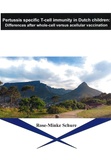Pertussis specific T-cell immunity in Dutch children
Differences after whole-cell versus acellular vaccination

Schure, Rose-Minke
- Promoter:
- Prof.dr. E.A.M. (Lieke) Sanders
- Co-promoter:
- Dr. A.M. (Annemarie) Buisman & dr. G.A.M. (Guy) Berbers
- Research group:
- Sanders
- Date:
- February 25, 2014
- Time:
- 12:45 h
Summary
Bordetella pertussis is the causative bacteria of whooping cough. Whooping cough is a highly contagious infection, which is characterized by coughing with whooping and post-tussive vomiting. In particular, infants under 6 months of age who have not been fully vaccinated, are at risk for serious complications or even death. Initially, pertussis vaccination was successful in protecting young children against whooping cough. However, despite high vaccination coverage rates in the Netherlands, the incidence of pertussis again increased since 1996, similar to the situation in many other countries. In 2012, the Netherlands experienced the largest pertussis epidemic since the start of vaccination in the 1950s, with over 8,000 notified disease cases. The current Dutch pertussis vaccination schedule consists of four primary pertussis vaccinations for infants administered at 2, 3, 4 and 11 months of age with an additional acellular preschool booster vaccination at 4 years of age. In this thesis we evaluated the effects of the change in 2005 from the whole cell pertussis (wP) infant vaccination to acellular (aP) vaccination of baby’s in preschool and school children. Despite waning antibody levels at 4 years of age, pertussis specific T-cell responses had remained present in both wP- and aP-primed children, but were much higher in aP-vaccinated than in wP-primed children. Moreover, there was only a limited to absent rise in the already high levels of all T-cell cytokines upon the preschool aP booster vaccination at 4 years of age in the aP-primed children. In contrast, a typical T-cell memory response was observed in wP-primed children with increased T-cell responses both after a low-dose or a high-dose aP preschool booster. We furthermore showed that the preschool aP booster a resulted in significantly higher pertussis-specific IgG antibody levels in aP-primed children compared with wP-primed children and that antibody levels remained higher for at least two years post-booster till age 6 years. The avidity of antibody responses was also higher in aP-primed children immediately post-booster compared to wP-primed children, but no differences were found anymore in 6-year-old children. We further demonstrated that pertussis-specific T-cell immunity in wP-primed children gradually had increased with age in children 6 and 9 years of age, two to five years following the aP booster vaccination at age 4 years, most probably due to natural contact with circulating pertussis bacteria. After an extra pertussis aP booster vaccination at age 9 years, the high pre-vaccination T-cell immune responses were only minimally enhanced upon the extra vaccination. In conclusion, evaluating cellular immune responses to pertussis vaccination in addition to antibody levels provides important information for recommendations about new vaccination schedules. Our findings suggest that it seems worthwhile to study the possible benefits of postponing the preschool pertussis booster vaccination to a later age and to use a low-dose vaccine. Development of new vaccines with longer lasting immunity is a future goal to prevent pertussis.